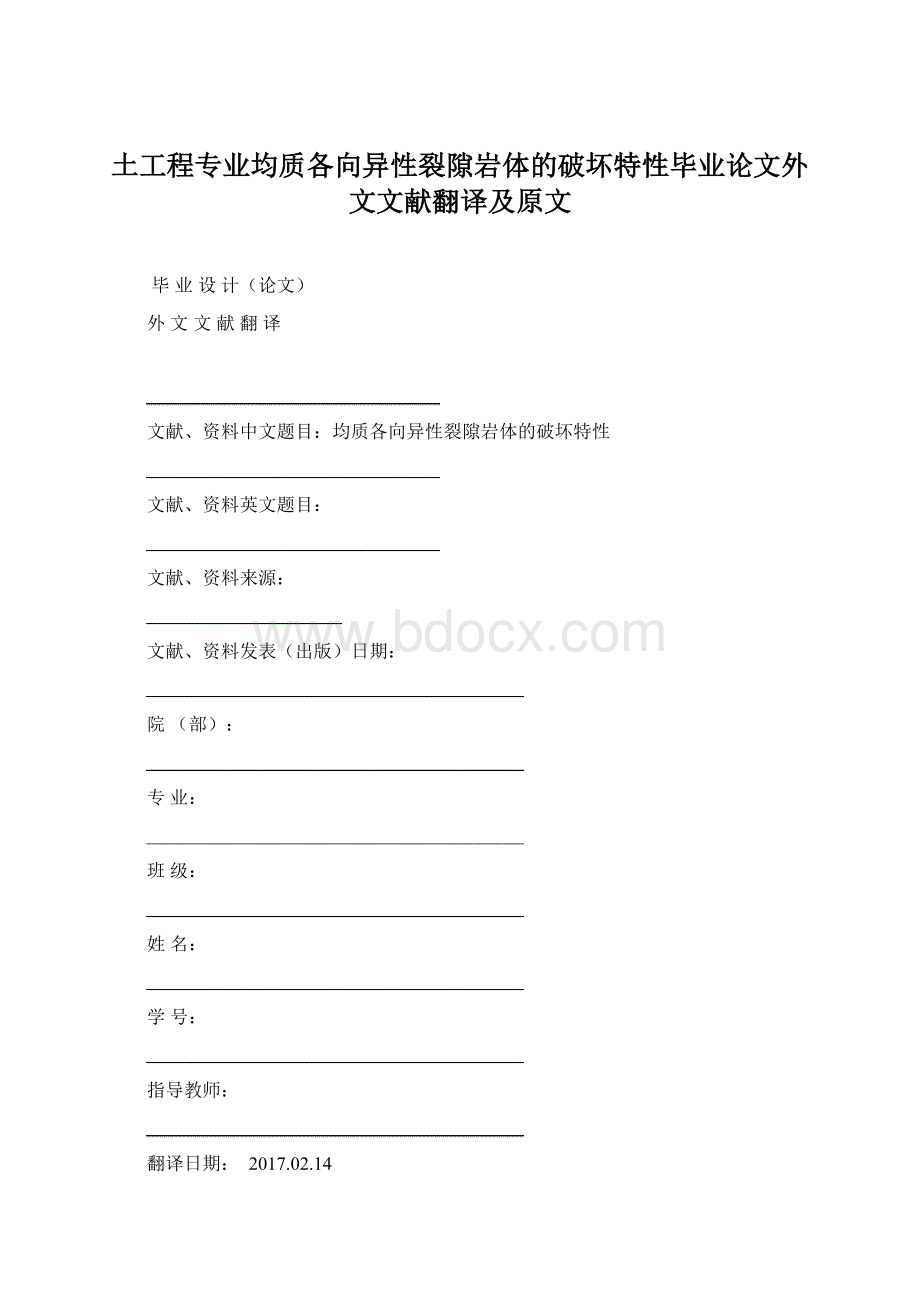土工程专业均质各向异性裂隙岩体的破坏特性毕业论文外文文献翻译及原文Word格式.docx
《土工程专业均质各向异性裂隙岩体的破坏特性毕业论文外文文献翻译及原文Word格式.docx》由会员分享,可在线阅读,更多相关《土工程专业均质各向异性裂隙岩体的破坏特性毕业论文外文文献翻译及原文Word格式.docx(15页珍藏版)》请在冰豆网上搜索。

文献、资料英文题目:
文献、资料来源:
文献、资料发表(出版)日期:
院(部):
专业:
班级:
姓名:
学号:
指导教师:
翻译日期:
2017.02.14
FailurePropertiesofFracturedRockMassesasAnisotropic
HomogenizedMedia
Introduction
Itiscommonlyacknowledgedthatrockmassesalwaysdisplaydiscontinuoussurfacesofvarioussizesandorientations,usuallyreferredtoasfracturesorjoints.Sincethelatterhavemuchpoorermechanicalcharacteristicsthantherockmaterial,theyplayadecisiveroleintheoverallbehaviorofrockstructures,whosedeformationaswellasfailurepatternsaremainlygovernedbythoseofthejoints.Itfollowsthat,fromageomechanicalengineeringstandpoint,designmethodsofstructuresinvolvingjointedrockmasses,mustabsolutelyaccountforsuch‘‘weakness’’surfacesintheiranalysis.
Themoststraightforwardwayofdealingwiththissituationistotreatthejointedrockmassasanassemblageofpiecesofintactrockmaterialinmutualinteractionthroughtheseparatingjointinterfaces.Manydesign-orientedmethodsrelatingtothiskindofapproachhavebeendevelopedinthepastdecades,amongthem,thewell-known‘‘blocktheory,’’whichattemptstoidentifypoten-
tiallyunstablelumpsofrockfromgeometricalandkinematicalconsiderations(GoodmanandShi1985;
Warburton1987;
Goodman1995).Oneshouldalsoquotethewidelyuseddistinctelementmethod,originatingfromtheworksofCundallandcoauthors(CundallandStrack1979;
Cundall1988),whichmakesuseofanexplicitfinite-differencenumericalschemeforcomputingthedisplacementsoftheblocksconsideredasrigidordeformablebodies.Inthiscontext,attentionisprimarilyfocusedontheformulationofrealisticmodelsfordescribingthejointbehavior.
Sincethepreviouslymentioneddirectapproachisbecominghighlycomplex,andthennumericallyuntractable,assoonasaverylargenumberofblocksisinvolved,itseemsadvisabletolookforalternativemethodssuchasthosederivedfromtheconceptofhomogenization.Actually,suchaconceptisalreadypartiallyconveyedinanempiricalfashionbythefamousHoekandBrown’scriterion(HoekandBrown1980;
Hoek1983).Itstemsfromtheintuitiveideathatfromamacroscopicpointofview,arockmassintersectedbyaregularnetworkofjointsurfaces,maybeperceivedasahomogeneouscontinuum.Furthermore,owingtotheexistenceofjointpreferentialorientations,oneshouldexpectsuchahomogenizedmaterialtoexhibitanisotropicproperties.
Theobjectiveofthepresentpaperistoderivearigorousformulationforthefailurecriterionofajointedrockmassasahomogenizedmedium,fromtheknowledgeofthejointsandrockmaterialrespectivecriteria.Intheparticularsituationwheretwomutuallyorthogonaljointsetsareconsidered,aclosed-formexpressionisobtained,givingclearevidenceoftherelatedstrengthanisotropy.Acomparisonisperformedonanillustrativeexamplebetweentheresultsproducedbythehomogenizationmethod,makinguseofthepreviouslydeterminedcriterion,andthoseobtainedbymeansofacomputercodebasedonthedistinctelementmethod.Itisshownthat,whilebothmethodsleadtoalmostidenticalresultsforadenselyfracturedrockmass,a‘‘size’’or‘‘scaleeffect’’isobservedinthecaseofalimitednumberofjoints.Thesecondpartofthepaperisthendevotedtoproposingamethodwhichattemptstocapturesuchascaleeffect,whilestilltakingadvantageofahomogenizationtechnique.ThisisachievedbyresortingtoamicropolarorCosseratcontinuumdescriptionofthefracturedrockmass,throughthederivationofageneralizedmacroscopicfailureconditionexpressedintermsofstressesandcouplestresses.Theimplementationofthismodelisfinallyillustratedonasimpleexample,showinghowitmayactuallyaccountforsuchascaleeffect.
ProblemStatementandPrincipleofHomogenizationApproach
Theproblemunderconsiderationisthatofafoundation(bridgepierorabutment)restinguponafracturedbedrock(Fig.1),whosebearing
capacityneedstobeevaluatedfromtheknowledgeofthestrengthcapacitiesoftherockmatrixandthejointinterfaces.ThefailureconditionoftheformerwillbeexpressedthroughtheclassicalMohr-Coulombconditionexpressedbymeansofthecohesion
andthefrictionangle
.Notethattensilestresseswillbecountedpositivethroughoutthepaper.
Likewise,thejointswillbemodeledasplaneinterfaces(representedbylinesinthefigure’splane).Theirstrengthpropertiesaredescribedbymeansofaconditioninvolvingthestressvectorofcomponents(σ,τ)actingatanypointofthoseinterfaces
Accordingtotheyielddesign(orlimitanalysis)reasoning,theabovestructurewillremainsafeunderagivenverticalloadQ(forceperunitlengthalongtheOzaxis),ifonecanexhibitthroughouttherockmassastressdistributionwhichsatisfiestheequilibriumequationsalongwiththestressboundaryconditions,whilecomplyingwiththestrengthrequirementexpressedatanypointofthestructure.
ThisproblemamountstoevaluatingtheultimateloadQ﹢beyondwhichfailurewilloccur,orequivalentlywithinwhichitsstabilityisensured.Duetothestrongheterogeneityofthejointedrockmass,insurmountabledifficultiesarelikelytoarisewhentryingtoimplementtheabovereasoningdirectly.Asregards,forinstance,thecasewherethestrengthpropertiesofthejointsareconsiderablylowerthanthoseoftherockmatrix,theimplementationofakinematicapproachwouldrequiretheuseoffailuremechanismsinvolvingvelocityjumpsacrossthejoints,sincethelatterwouldconstitutepreferentialzonesfortheoccurrenceof
failure.Indeed,suchadirectapproachwhichisappliedinmostclassicaldesignmethods,isbecomingrapidlycomplexasthedensityofjointsincreases,thatisasthetypicaljointspacinglisbecomingsmallincomparisonwithacharacteristiclengthofthestructuresuchasthefoundationwidthB.
Insuchasituation,theuseofanalternativeapproachbasedontheideaofhomogenizationandrelatedconceptofmacroscopicequivalentcontinuumforthejointedrockmass,maybeappropriatefordealingwithsuchaproblem.Moredetailsaboutthistheory,appliedinthecontextofreinforcedsoilandrockmechanics,willbefoundin(deBuhanetal.1989;
deBuhanandSalenc,on1990;
Bernaudetal.1995).
MacroscopicFailureConditionforJointedRockMass
Theformulationofthemacroscopicfailureconditionofajointedrockmassmaybeobtainedfromthesolutionofanauxiliaryyielddesignboundary-valueproblemattachedtoaunitrepresentativecellofjointedrock(BekaertandMaghous1996;
Maghousetal.1998).Itwillnowbeexplicitlyformulatedintheparticularsituationoftwomutuallyorthogonalsetsofjointsunderplanestrainconditions.ReferringtoanorthonormalframeO
whoseaxesareplacedalongthejointsdirections,andintroducingthefollowingchangeofstressvariables:
suchamacroscopicfailureconditionsimplybecomes
whereitwillbeassumedthat
Aconvenientrepresentationofthemacroscopiccriterionistodrawthestrengthenveloperelatingtoanorientedfacetofthehomogenizedmaterial,whoseunitnormalnIisinclinedbyanangleawithrespecttothejointdirection.Denotingby
and
thenormalandshearcomponentsofthestressvectoractinguponsuchafacet,itispossibletodetermineforanyvalueofathesetofadmissiblestresses(
)deducedfromconditions(3)expressedintermsof(
).ThecorrespondingdomainhasbeendrawninFig.2intheparticularcasewhere
.
Twocommentsareworthbeingmade:
1.ThedecreaseinstrengthofarockmaterialduetothepresenceofjointsisclearlyillustratedbyFig.2.Theusualstrengthenvelopecorrespondingtotherockmatrixfailureconditionis‘‘truncated’’bytwoorthogonalsemilinesassoonascondition
isfulfilled.
2.Themacroscopicanisotropyisalsoquiteapparent,sinceforinstancethestrengthenvelopedrawninFig.2isdependentonthefacetorientationa.Theusualnotionofintrinsiccurveshouldthereforebediscarded,butalsotheconceptsofanisotropiccohesionandfrictionangleastentativelyintroducedbyJaeger(1960),orMcLamoreandGray(1967).
NorcansuchananisotropybeproperlydescribedbymeansofcriteriabasedonanextensionoftheclassicalMohr-Coulombconditionusingtheconceptofanisotropytensor(BoehlerandSawczuk1977;
Nova1980;
AllirotandBochler1981).
ApplicationtoStabilityofJointedRockExcavation
Theclosed-formexpression(3)obtainedforthemacroscopicfailurecondition,makesitthenpossibletoperformthefailuredesignofanystructurebuiltinsuchamaterial,suchastheexcavationshowninFig.3,
wherehandβdenotetheexcavationheightandtheslopeangle,respectively.Sincenosurchargeisappliedtothestructure,thespecificweightγoftheconstituentmaterialwillobviouslyconstitutethesoleloadingparameterofthesystem.Assessingthestabilityofthisstructurewillamounttoevaluatingthemaximumpossibleheighth+beyondwhichfailurewilloccur.Astandarddimensionalanalysisofthisproblemshowsthatthiscriticalheightmaybeputintheform
whereθ=jointorientationandK+=nondimensionalfactorgoverningthestabilityoftheexcavation.Upper-boundestimatesofthisfactorwillnowbedeterminedbymeansoftheyielddesignkinematicapproach,usingtwokindsoffailuremechanismsshowninFig.4.
RotationalFailureMechanism[Fig.4(a)]
Thefirstclassoffailuremechanismsconsideredintheanalysisisadirecttranspositionofthoseusuallyemployedforhomogeneousandisotropicsoilorrockslop